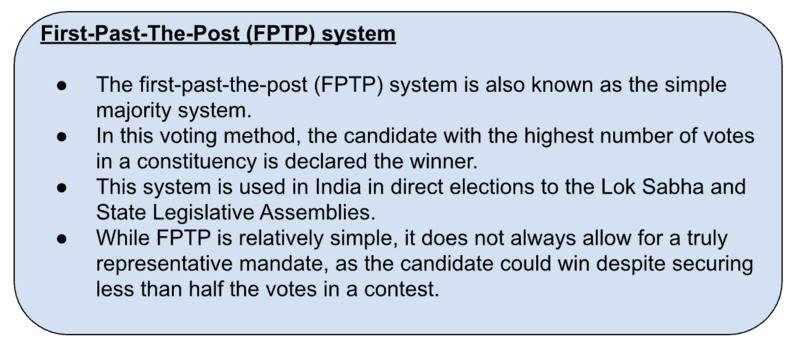Why in News?
- The comparison between Auckland and Odisha shares a stark difference in terms of the Human Development Index, education levels, and socio-economic indicators. However, in terms of political behaviour they resemble similarities.
- The Assembly election of Odisha collided with Lok Sabha elections in 2019 leading to simultaneous elections in the state. In state elections the BJD won with a thumping majority while in the Parliamentary election BJD was not that effective which signals the split in voting patterns. It also indicates that voters made distinct choices at the national and regional levels, highlighting the complexity of voter behavior.
- The article discusses about split voting behavior and Mixed Member Proportional(MMP) system.
Mixed Member Proportional (MMP) system:
- The MMP system allows voters to cast two votes, one for the candidate and one for the party.
- New Zealand uses the Mixed Member Proportional (MMP) system, which allows voters to cast two votes: one for a local candidate and another for a political party.
- This system permits voters to choose candidates from different parties for the local and national levels, without affecting the overall party representation in Parliament.

India’s Voting system:
- In India the voting system is different from New zealand. Here voters only give their vote to the candidate of any political party and the number of elected candidates decides the victory of a party.
- Here the number of winning candidates in a poll decides the formation of the government.
- In the Indian electoral framework, compulsory voting often limits the liberty of voters to express their genuine preferences. Voters may hesitate to vote for candidates outside their preferred party or perceived winnable contenders due to the fear of potential repercussions on the broader political landscape.
Advantages of MMP System:
- Proportional Representation: In this the share of seats a party wins closely mirrors its share of the popular vote. As a result, it tends to create a fairer and more representative political landscape.
- Diverse Representation: MMP tends to provide better representation for a variety of political ideologies and minority groups.
- Local Representation: Voters can still choose a local representative, often in a single-member constituency, while also expressing their preference for a political party.
- No "Wasted" Votes: Even if a party doesn't win any local seats, its share of the party vote can still contribute to its representation in the legislature through the allocation of list seats.
- Stability and Coalitions: MMP often leads to coalition governments, which can promote political stability as parties need to cooperate and compromise to form a government.
- Accountability: Elected representatives are accountable to both their party and their local constituents, which can help ensure that they address both local and national issues.
- Flexibility: Voters have the flexibility to choose different parties for their local and national preferences. This allows for more nuanced voting and better reflects the diversity of voter opinions.
Disadvantages of MMP System
- Complexity: MMP systems can be relatively complex for voters to understand. The need to cast two separate votes, one for a local candidate and one for a political party, can lead to confusion and potentially lower voter turnout.
- Risk of Fragmented Parliaments: In some cases, MMP systems may lead to the proliferation of small parties. While this can enhance representation, it can also result in a fragmented parliament where coalition governments are necessary, potentially leading to instability and difficulties in forming consensus.
- Tactical Voting: There can be instances of tactical voting, where voters support a party they don't necessarily endorse to prevent another party from gaining power. This strategic voting can distort the true preferences of voters.
- Overrepresentation of Smaller Parties: In some MMP systems, smaller parties may have a disproportionate influence in coalition negotiations and policymaking, potentially leading to policy outcomes that do not reflect the preferences of the majority of voters.
- Difficulty in Removing Underperforming Representatives: Since MMP often results in a combination of local and list candidates, it can be challenging to hold underperforming representatives accountable, as voters may not have a direct say in their selection.
Challenges in Indian context:
- Voters Mindset: The MMP system may prompt tactical voting, where voters might support a party that they don’t necessarily endorse just to keep another party out of power.
- Electoral education: In India there are a lot of people who are still not comfortable with Electronic voting machines and VVPAT and also still they have no personal view about politics because of lack of education.
- Fund issue: India is a large country and election expenses are very high. In this scenario, try a new system where at least two EVM machines are needed in one poll booth.
- Electoral issues: In a country like India it is not possible to implement any reforms which are easily implemented in any small country like New zealand. There will be lots of issues arising like political issues, technological issues and financial issues etc.
Conclusion:
The MMP system Provides flexibility to voters to choose candidates based on merit in the meantime ensuring that party preference determines legislative composition and this ability to distinguish between candidate and party is a symbol of mature democracy. In the Indian context It could address issues related to compulsive voting and allow Indian voters to select candidates based on merit while still ensuring that their party preference influences legislative composition.
Mains PYQs
Q. To enhance the quality of democracy in India the Election Commission of India has proposed electoral reforms in 2016. What are the suggested reforms and how far are they significant to make democracy successful? (UPSC 2017)


